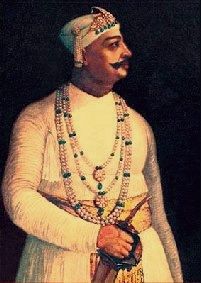Asaf Jah III.
Mir Akbar Ali Khan Siddiqi Sikander Jah Asaf Jah III. (* November 11, 1768 in Hyderabad ; † May 21, 1829 ), was as Nizam from 1803 to 1829 the absolute ruler of the Indian princely state of Hyderabad in the highlands of the Deccan .
Domination
Although he initially resisted being treated as a second-rate ally of the British, from 1808 he had to acknowledge that the French had lost their power in India. The resident became the last resort on many issues. His power was visible to everyone in the imposing official building in the Chādargāt district. The British permanently stationed the troops, which were equipped by the Nizam but commanded by them, in the Secunderabad Cantonement, which was then 10 km from the capital .
In 1808, the Nizam was forced to use the British-friendly Hindu Chandu Lal as minister, who remained in office until September 6, 1843. This soon dominated the administration, the actual divan Munir ul-Mulk and the Nizam withdrew from official business and instead cultivated a dissolute lifestyle and intrigue at court. The divan alone left Rs. 2.5 million in debt at his death . The ruler's sons lived on a similar footing. With the payments for the Subsidiary Force one fell more and more into arrears. Despite this, the expansion of the magnificent Chowmahalla Palace continued. The expansion of the Purani Haveli Palace also fell under his rule .
Chandu Lal began to sell fiefs ( jagir ) with the right to collect taxes, and corruption grew to enormous proportions, even for a Muslim despotism in the East. In 1816, with the approval of the Governor General, the minister took out a loan from the Hyderabad-based company Palmer & Co. , which brought the country into debt bondage. A second loan in 1820 was not approved when, after examination by the new resident Charles Metcalfe, it was found that nearly £ 1 million (equivalent to £ 90.5 million in today's purchasing power) had been borrowed and wasted at rates of up to 24%. Further lending was forbidden and the North Circars income was used to service debt, but only 6% interest was paid. Palmer & Co. soon went bankrupt. However, waste and debt remained.
The treaty of 1822 regulated border issues and released the ruler from the obligation to pay tribute ( chauth ).
His tomb, like that of his next three successors, is in the capital's Mecca mosque .
family
He was married first to Jahan Parwar Begum Sahiba ( Haji Begum ), daughter of Nawab Saif ul-Mulk ( Maali Mian ) in May 1800. Fazilath Unisa Begum ( Chandni Begum ) followed as the second wife .
He had a total of ten sons and nine daughters, including the more important ones:
- Naser ad-Daula Farkhunda Ali Khan Asaf Jah IV.
- Mir Gawhar Ali Khan Mubarizuddaula, † 1854
- Zulfiqar ul-Mulk
- Shamsam ul-Mulk
Individual evidence
- ↑ Diwan Munir ul-Mulk was married to a daughter of Mir Alam , later the grandfather of Salar Jung I.
- ↑ Required according to: Act 37, Geo. III, cap. 142 from 1796
- ↑ The new loan should be £ 600,000 at 18% interest, Directors will receive Rs. 80,000 commission. Lord Hastings , who had relied on the resident's advice to approve it in 1816, now condemned the arrangement. However, since one of Palmer & Co.'s partners, William Rumbold, was married to a Hastings foster daughter, responsibility was passed on to him. Although the directors of the company supported him, he resigned because of these allegations in late 1822. Details in the Hyderabad Papers 1825, pp. 6, 40, 72, 186. (A greedy descendant, Sir Horace Rumbold [* 1829], British envoy in Athens, tried to collect the commission 50 years later when he visited Hyderabad. Manchester Examiner , January 13, 1888)
- ^ Karl Marx : Notes on Indian History ; Moscow²s.n. (after 1947), p. 122
Web links
| personal data | |
|---|---|
| SURNAME | Asaf Jah III. |
| ALTERNATIVE NAMES | Sikandar Jah (nickname) |
| BRIEF DESCRIPTION | Waste- seeking Nizam of the Indian princely state of Hyderabad (1803–1829) |
| DATE OF BIRTH | November 11, 1768 |
| PLACE OF BIRTH | Hyderabad (Deccan) |
| DATE OF DEATH | May 21, 1829 |
| Place of death | Hyderabad (Deccan) |

